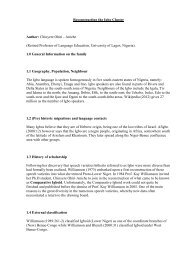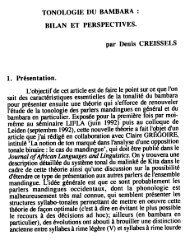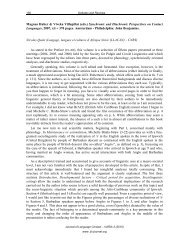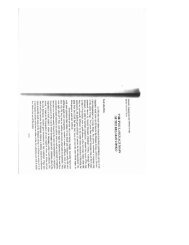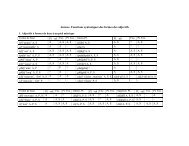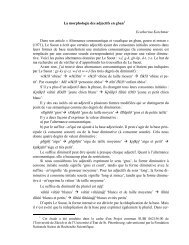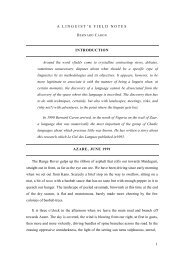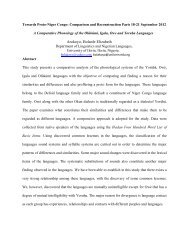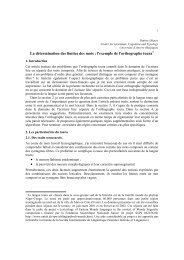Kru revisited, Kru revealed Lynell Marchese Zogbo ... - Llacan
Kru revisited, Kru revealed Lynell Marchese Zogbo ... - Llacan
Kru revisited, Kru revealed Lynell Marchese Zogbo ... - Llacan
You also want an ePaper? Increase the reach of your titles
YUMPU automatically turns print PDFs into web optimized ePapers that Google loves.
<strong>Kru</strong> <strong>revisited</strong>, <strong>Kru</strong> <strong>revealed</strong><br />
<strong>Lynell</strong> <strong>Marchese</strong> <strong>Zogbo</strong><br />
Welcome to the KRU (“crew”) language family<br />
• Very small under 12 million speakers<br />
• Limited to Côte d’Ivoire and Liberia, with <strong>Kru</strong><br />
settlements Freetown Ghana<br />
• Past documentation rare (Koelle 1800’s,<br />
Delafosse 1904, Thomann 1906)<br />
• Dense forest, no kings, no classes, no masks (at 1 pt)!<br />
endangered? <strong>Kru</strong>s learn other langs, not reverse<br />
• Recent surge in research from late 60’s til present:<br />
-published grammars: Thomann, Innes, G. <strong>Zogbo</strong>;<br />
-doctoral dissertations: Kokora, Grah, Egner, G. <strong>Zogbo</strong>,<br />
Saunders, <strong>Marchese</strong>, Thalmann;<br />
-UQAM group: Kaye, Koopman, et al.;<br />
-SIL research: Bentinck, Leidenfrost, etc.<br />
-ILA theses and publications<br />
-<strong>Kru</strong> Atlas 1979 and Tense/Aspect and the development of auxiliaries in <strong>Kru</strong> (1979)<br />
• standard Niger-Congo features: noun class remnants, verbal extensions, a *CVCV word<br />
structure, labio-velars and at least one implosive stop, ATR vowel harmony, nasalized<br />
vowels in one half of family, and three to four level tones, as well as common lexical roots<br />
CLASSIFICATION<br />
Within Niger-Congo<br />
• independent by Westermann and<br />
Bryan<br />
• under Kwa by Greenberg (refuted<br />
by Welmers, Williamson)<br />
• linked to Gur (Bennett and Sterk)<br />
• Williamson and Blench (2000) have<br />
<strong>Kru</strong> under Proto Volta-Congo<br />
Needs a lot more work!<br />
Compelling : noun class suffixes<br />
Proto-Niger-Congo<br />
________Kordofanian<br />
Proto-Mande-Atlantic-Congo<br />
Atlantic___________________________Mande<br />
Proto-Ijo-Congo<br />
____________Ijoid<br />
Proto-Dogon-Congo<br />
Dogon___________<br />
Proto-Volta-Congo<br />
*West Volta-Congo East Volta-Congo=Proto Benue Kwa<br />
KRU Kwa…Benue…Bantoid<br />
Pre Gur-Adamawa<br />
Senufo
Internal classification<br />
Delafosse (1904) proposed division into two groups, Bakwé and Bété, now called Western and Eastern,<br />
divided by Sassandra river: There are several isolates:<br />
• Kuwaa and Dewoin in Liberia (confirmed)<br />
• Aizi in Côte d’Ivoire (confirmed)<br />
• Sεmε in Burkina Faso (not confirmed)<br />
West-East division demonstrated by correspondences, isoglosses & phonological feature:nasalized V’s<br />
t : s PWK *tu PEK *su<br />
‘tree’ tū Nyabwa sū Neyo<br />
tū Wobé sū Godie<br />
tū Gueré sū Dida Y<br />
tūgbὲ Tepo sū Bete GU, Bete GB<br />
tū Klao sū Kouya<br />
tuū́ Bakwe<br />
cu Bassa *tu > cu.<br />
ɲ: ŋ PWK *ɲ PEK *ŋ<br />
‘name’ ɲlɩ́ Nyabwa ŋlɩ́ Bete (D)<br />
ɲɩńɩ́ Wobé ŋlɩ́ Dida (Y)<br />
ɲnɩ́ Guere ŋnɩ́ Kouyo<br />
ɲnέ Klao ŋlʉ H Godié<br />
ɲrɩ́ Bakwe
‘woman’ PWK *ɲ PEK *ŋ<br />
ɲnɔ́ Krahn (T) ŋlɔ́ Neyo<br />
ɲrʋgba Tepo ŋwlɔ́ Godie<br />
ɲnɔ́ Guere ŋlɔ́ Dida Y<br />
ɲnáákpʋ̄ Wobe ŋɔ́ Dida L<br />
ŋlɔ̄ Bete<br />
ŋwnɔ́ Kouya<br />
ŋlʋ́ʋ́ Bakwé<br />
Note that here Bakwe shows a Western form for ‘name’ and an Eastern one for ‘woman’.<br />
gb: gw<br />
‘dog PWK *gbe M PEK *gwɩ<br />
Nyabwa gbē Godie gwe-yi<br />
Wobe gbē Dida go-yi<br />
Guere gbē Bete GU gwɩ̄<br />
Tepo gbì Bete GB gwē<br />
Klao gbè Bete D gwɩ̄<br />
Bassa gbē Kouya gwɩ̄<br />
Bakwé and Neyo show fricatives for this lexical item. Neyo has vɩ or vɔ M and Bakwe, fɛ L.<br />
Numerous isoglosses:<br />
Western Eastern<br />
‘fire’ PWK *nε PEK *kosu<br />
Nyabwa nε̄ Neyo kòsù<br />
Wobé nε̄ Godie kòsú<br />
Guere nε̄ Dida (Y) kòsù<br />
Tepo nā Bete-G kòsù<br />
‘tooth’ PW *nynɩ H PKE *gle M<br />
Nyabwa ɲnɩ́ Neyo grē<br />
Wobé ɲnɩ́ /nynɩε Godie glē<br />
Guéré ɲnɩ́ɛ̀ Bete (GU) glē-yì<br />
Tepo ɲέε̄ Bete (GB) glε̄<br />
Klao ɲέ Bete (D) glē-yī<br />
Bassa ɲεńέ Kouya gla 1<br />
Bakwé glὲ<br />
Questions: Eastern Neyo? Dida? border languages Bakwé, Kouya ; Western subgroup Wè vs <strong>Kru</strong> ;<br />
1 This is the plural of gle in many languages.
PROTO-PHONOLOGY<br />
*CVCV-(C) V & probably *CVV ; current CLV and syncopated syllable types are derived<br />
*Four level tones, with a few examples of 4 > 3, innovated modulated tones resulting from toneconsonant<br />
interaction and consonant voicing; tone carries a high functional load in the lexicon and in<br />
the grammar: distinguishing 1-2 nd person (sg and pl), perfective-imperfective, negation<br />
egg<br />
Proto <strong>Kru</strong> Initial consonants (<strong>Marchese</strong> unpublished, 1976) current analysis<br />
p b c g kp p t k kp<br />
b d ɟ k gb b d g gb<br />
m n ɲ ng ɓ l w<br />
s m n ? ?<br />
z w s<br />
kw, gw derived from CVV c, j, ny derived? g > ɟ gie> ɟ ie<br />
l realized as flap l, r, n, ɗ ???relationship bt l-d-ɗ,<br />
c, s > h in several <strong>Kru</strong> languages *y<br />
k > f, s > z z, s > f v? g > gh group of Bete<br />
*ɓ Ny Wob Guer Tep Bass Bakw Kouy BeD BeG Godi Ney De<br />
Leg ɓʋ̄ ɓʋ̄ ɓʋ̄ ɓʋ̀ ɓo bɔ̄ʋ́ ɓʋ̄ ɓʋ2 ɓō ɓɔ̀ɔ́ ɓō<br />
Two stages Proto <strong>Kru</strong> I (oldest ) and Proto <strong>Kru</strong> II<br />
Proto-<strong>Kru</strong> II ‘bush’ kwálá or kwlá < Proto <strong>Kru</strong> I **kʋlá<br />
‘moon’ *cʋ h < Proto <strong>Kru</strong> I **kí-ʋ (Kuwaa: kewu)<br />
‘dew’ *ɟ lù < Proto <strong>Kru</strong> I **dilù<br />
‘breast *ɲiti < Proto <strong>Kru</strong> I ?<br />
n…………………………..ng(w) ………………… …w<br />
‘mouth’ nё, ne Godie, Neyo ngwε Kouya, wɔn Klao, Bassa<br />
ngo Bete D wɩ Tepo<strong>Kru</strong>men<br />
nguo Wobe, Guere wɔɩ Dewoin<br />
‘hear’ nú Neyo, Godie, Dida ngwɔ Grebo wɔn Tepo, Klao, Bassa<br />
nʋ̄ Bete, Kouya<br />
CompareWilliamson and Bench (2000:41)<br />
*Western Sudan Kordonfanian *Proto-<strong>Kru</strong><br />
#nu, ‘hear’ -eenu ‘ear’ *nú? ‘hear’
#nu, -nua ‘mouth’ *uungu *nV? ‘mouth’<br />
VOWELS<br />
Proto <strong>Kru</strong> oral vowels PWK Nasalized<br />
ɩ ʋ ɩn ʋn<br />
e o<br />
ε ɔ εn ɔn<br />
a an<br />
*vowel harmony everywhere: retracted but some +height<br />
*predictable nasalization after nasal C or N dropping<br />
*divide: nasalized Vs in West, almost none in East; all nasalized V’s except e & o<br />
Western (nasalized vowels)<br />
Nyabwa Wobe Guere Klao Bassa<br />
Tail gʋn M gʋn M gʋn M wɔn M vɔn M<br />
Arm sʋn M sʋn M sʋn M sɔn M<br />
Two sɔn H sɔn H sɔn H sɔn H sɔn H<br />
Eastern (oral vowels)<br />
Neyo Godie Dida BeteGGB Koouya<br />
tail gʋ go M go M go-yì<br />
Arm sɔ sɔ sɔ sɔ<br />
Two sɔ H sɔ H mɔsɔ BH sɔ sɔ H<br />
Complementary distribution in Western <strong>Kru</strong><br />
Klao (Singler): voiced stops and oral Vs /dan/ [nan] MH ‘drink’ vs /da/ ‘call’MH, never<br />
[dan], never [ma], but distinction with voiceless stops: pi ‘cook’ pin M ‘load (on head)’<br />
Did Proto-<strong>Kru</strong> have nasalized V’s or not? If so, what triggered de-nasalization in Eastern <strong>Kru</strong>?<br />
Positing proto nasalized vowels and no nasal consonants (Le Saout, Bole-Richard, Vydrine for<br />
Mande) doesn’t work for East <strong>Kru</strong>. Could <strong>Kru</strong> have borrowed nasalized vowels from Mande??<br />
Central vowels : innovated in Eastern <strong>Kru</strong> (Bete, Godie) but not in Dida and Neyo:<br />
i ï U<br />
ɩ ʉ ʋ<br />
e ə O<br />
ɛ ʌ ɔ<br />
a<br />
Bakwé has central vowels, is it genetic or areal? Why this innovation? SMande=central V’s<br />
Note weird fact: where central vowels occur, there are no nasalized Vs!!!
PROTO-MORPHO-SYNTAX<br />
TAM<br />
• Currently SVO, but much OV typology:<br />
-ɔ lï sʉkʌ (SVO) ɔ yi sʉkʌ lï (S AUX O V)<br />
‘he eats rice’ ‘he will eat rice’<br />
-GEN N with or without associative*a (alienable/inalienable)Nyabwa gbe á kpá bone of dog<br />
-N Postposition<br />
-OV noun compounding<br />
• <strong>Kru</strong> is 100% suffixing: plurals in nouns & verbs (extensions: applic, passive, valency)<br />
• No serial verbs but conjoined propositions with AUX sequential from ‘come’<br />
• Comparison: expressed by *proto ‘pass’ construction: *X is good pass Y<br />
• Topic-comment style with front shifted focus, affirmative focus particles within clause<br />
Aspect dominates: perfective and imperfective reconstructed for Proto <strong>Kru</strong> with perfective<br />
basically an unmarked verb stem (but there is a pervasive low tone throughout the family).<br />
Proto imperfective is the marked form, reconstructing to *NP a V-e (<strong>Marchese</strong>, 1982)<br />
Which is older? Both persist. In some languages a has suffixed onto NP, producing an<br />
imperfective pronoun set. In others a is lost. In many languages –e reduces to mid tone. Did<br />
low perfective tone marking innovate to provide a clear distinction (dissimilation)? Did a proto<br />
tense marker get re-analyzed, then reduce to low tone (contra expectation tense > aspect)?<br />
There is a proto periphrastic progressive * he is-at bathe-place ‘he is bathing’.<br />
Tense is secondary. Some evidence of recent and remote past tense suffixes: #a or #i ‘recent’<br />
(Godie, Dewoin) and #o/wo, wʌ (remote). But extensive tense innovation derived from temporal<br />
adverbs most extensively in the <strong>Kru</strong> cluster (Klao, Cedepo, TepoKroumen, Bassa, etc). (See<br />
<strong>Marchese</strong>, 1984). The innovative tenses range from 1 to 5, highest in Grebo (Innes, 1969):<br />
(i) né dú blà. ʻI pounded rice ʼ.<br />
I pound rice<br />
(ii) né dú-da blà. ʻ I pounded rice the day before yesterday ʼ.<br />
(iii) né dú-d́ blà. ʻI pounded rice yesterday. ʼ<br />
(iv) né dú- blà. ʻ I pounded rice today.ʼ<br />
(v) né dú-a blà. ʻ I will pound rice tomorrow.ʼ<br />
(vi) né dú-d blà ʻI will pound rice the day after tomorrow. ʼ<br />
Auxiliaries express future, potential, perfect, sequential, negation, relatively recent development<br />
and currently on-going : SV (O)V-nom S AUX (O) V, (1986)
‘come’ future, sequential, potential; ‘have’ future, conditional, ‘bring’? .perfective,<br />
‘stop’, let go’ NEG markers. True reanalysis : Aux: no perf-imperf, take obj & tense suffixes<br />
NOUN CLASSES and AGREEMENT<br />
Proto <strong>Kru</strong> words were made up of *STEM + Class suffix<br />
Vestiges seen in:<br />
Pronouns:<br />
• Pronoun systems 3 rd person<br />
• Singular + plural forms : regular and irregular<br />
• In some languages, in definite markers<br />
• Remnants of concord<br />
Primary distinction is human vs non human:<br />
3 rd singular with hierarchy human > big animals > everything else<br />
Human Non-human<br />
Kuwaa (isolate) ɔ ɛ̄<br />
Niaboua (Wè) ɔ̄ ɛ̄<br />
Wobé (Wè) ɔ̄ ɛ̄<br />
Grebo (<strong>Kru</strong> cluster, W) ɔ ɛ<br />
Djabo ɔ ɛ<br />
Kouya (East) ɔ we<br />
Tepo <strong>Kru</strong> (<strong>Kru</strong> cluster, W) ɔ ɛ, o, ɔ<br />
Neyo (E) ɔ ɛ, a, ʋ<br />
Godié (E) ɔ̄ ɛ, a, ʋ<br />
Bété (Daloa) (E) ɔ́ ɛ, a, ʋ 2<br />
Dida (Yocoboué)<br />
ɔ ɛ, a, ʋ<br />
On the basis of these pronouns, we posit for 3 rd singular human *ɔ and three non-human classes<br />
*ɛ, *a, *ʋ. In many cases there are clear semantic categories which link to class markers and or<br />
remnants in other families. Currently, however, this system is described phonologically by all<br />
(Grah, Kaye, <strong>Marchese</strong>, Sauder, Saunders, Thalmann, Werle, <strong>Zogbo</strong>): in Eastern <strong>Kru</strong>, NHum<br />
words ending in front V’s take ɛ, central Vs, a, back Vs, ʋ, but final V reflects old noun class<br />
marker.<br />
In Godié nouns ending in front vowels belong to the *ɛ big animal class (many taking –a in the<br />
plural):<br />
mlɛ “animal” Ɉɛ “antilope<br />
lʋɛ “elephant” glɛ “monky” (SP)
kaɓɛ “monkey”(SP) tlɛ “snake”<br />
gbalɛ “hippopotamus” bɔlɛ “monkey”<br />
ɓlɛ “buffalo” gwɛ “chimpanzee”<br />
ɓaɓlɛ “sheep” ɓlɛ “antelope”<br />
kpəkɛ “crocodile” Ɉɩ “panther”<br />
dʋdʋzʋɛ “anteater” ɓlɩ “cow”<br />
Compare other families for the word ‘goat’ 3:<br />
Yoruba e-wúrɛ́<br />
Efik e-bot<br />
Igbo e-wu<br />
Proto-bantu ɩN-boli<br />
Kordofanian e-bonyi<br />
<strong>Kru</strong> (Godié) wuli-ɛ (definite form)<br />
Godié nouns ending in back vowels take the *ʋ pronoun. Note liquids and mass.<br />
liquids non –solid masses<br />
ɲʋ́ “water” jlʋ̀ “fog”<br />
ɓlʋ “milk” vʋvɔlʋ “wind”<br />
dlʋ “blood” gbaylʋ “smoke”<br />
nʋ “alcoholic drink” ɓàɓʋ̀ “dust”<br />
zo “soup” nyɔmʋ “air”<br />
bubʋ “sweat” zùzʋ “spirit, shadow”<br />
natural elements miscellaneous (these take ɩ in plural)<br />
kòsu “fire” wlʋ́ “head”<br />
lagɔ “sky, God” lʋ “song”<br />
dʋdʋ “earth” blɔ “road”<br />
glʋ “soil” ylʋ “day”<br />
ylʋ “sun”<br />
cʋ “moon, month”<br />
Compare PB 3/4 mʋ/mi , PBenue-Congo ʋ/(ɩ)I, Togo Remnant *o/*i , the *o –prefix in Yoruba:<br />
omi “water” ɔna “road” ɔbɛ “soup” orin “ song”<br />
ɔrun “heaven” ošu “moon” ori “head”<br />
The a class is not so definable, but includes food, instruments, small insects, etc. Examples from Godie :<br />
sʉkʌ ‘rice’, nimlə ‘bird’, nyidə ‘cooking pot’; Bete (G): ɟá ‘wound’, mla ‘nose’, zɩa, ‘bird’.<br />
Reconstruction of noun stems is difficult because the noun class V suffix has ‘taken its spot’:
*ní +ʋ ɲú ‘water’ *lʋ-ε ‘elephant’ *yVlV- ʋ ‘sun’ nV + ʋ ‘alcoholic drink’<br />
Class concord or agreement is reflected across the family first and foremost in pronouns:<br />
subject, object, possessive, relative, interrogative, without overt reference in discourse.<br />
Within the NP, concord marks various elements, depending on the language:<br />
noun +adjective + demonstrative + number (definite floating)<br />
Godie ɓìtì kʌdɩ HL nɩ sɔ ‘those two big houses’<br />
Nyukpɔ kʌdɔ nɔ nii mlε kʌdε. Nykpɔɔ -ɔ nii mlε nʌ, ɔ kʋ ɔ ɓutu kádʋ<br />
‘man big DEM saw animal big Man-def REL saw animal SUB, he is-at his house big<br />
The big man saw a large animal’. . ‘The man who saw an animal is in his big house.<br />
Noun + Adjective + Demonstrative Noun + definite<br />
nyʉ̄kpɔ̄ kʌ́dɔ̄ nɔ̄ ‘this big (great) man’ nyʉ̄kpɔ̄ + ɔ LM ‘the man’<br />
ɓùtu kʌ̀dʋ nʋ ‘this big house’ li + ε lie ‘the spear’<br />
mlɛ̄ kʌ̍d̍ɛ̄ nɛ̄ ‘this big animal’ ɓùtù + ʋ ɓùtùu ‘the house’<br />
nmlə kʌ̍dʌ̄ nʌ̄ ‘this big bird’<br />
ɓı ̀tı̄ kʌ̍dɩ̄ nɩ̄ ‘these big houses’<br />
nyʉ̄kpà kʌ́dʋa nʋa ‘these big (great) men’<br />
The same agreement system exists in Bakwé, as seen in the following<br />
Noun + adjective ‘only’ 4<br />
nyɔɔ ˈdoolɔ le seul homme<br />
tatu ˈdoolʋ la seule porte<br />
sapɛ ˈdeelɛ le seul poulet<br />
ˈkpata ˈdöölä la seule chaise<br />
For adjectives, the situation varies greatly from language to language. Some agree with class and<br />
number as in Godie and Bakwe forms above, while some only agree in number. Where there is<br />
adjective class agreement, only a subset of adjectives agree, often the words ‘big’, ‘white’, ‘red’ and<br />
‘new’. As the class agreement diminishes, plural agreement can remain. But note that for Tchien<br />
Krahn, Sauder reports the qualified nouns take the non-human plural marker5. True everywhere<br />
nyɔ klàbá ‘an important person/ man’ (big) nyʋ klàbɩ ‘important people’<br />
dε zʋ n ‘bad thing’ dɩ zʋɩn ‘bad things’ nyʋ zʋɩn ‘bad people’<br />
Tepo <strong>Kru</strong>men6: ya ká yɩ kɩ ‘old pot/pots’<br />
hru pεtú hri pεti ‘short road/roads’<br />
yu yrayrʋ yuó yrayrɩ ‘new child/children<br />
4<br />
Examples from Csaba Leidenfrost.<br />
5<br />
Sauder, p. 46<br />
6<br />
Thalman. P. 251
The less the number of pronoun (class) distinctions, the less concord within the NP. The closer<br />
the element to the head noun, the more likelihood of agreement (no 1 st , dem/def 2 nd ). The loss<br />
of agreement in adj works its way through the lexicon, class marked colors & plurals resisting.<br />
Language Dem Adj1 Def Adj2 Num<br />
Godié X x/10 X x/4? 0<br />
Bété (Guibéroua) X X X X/? 0<br />
Neyo X X X X/? 0<br />
Wobe X X/10 NR x/1 0<br />
Kouya 0 X NR ? 0<br />
Grebo X S ? 0 0<br />
Kuwaa SG/PL X/1 X 0<br />
KLao 0 X 0 0 0<br />
Dewoin 0 ? 0 0 0<br />
X = agreement present<br />
0 = no agreement<br />
Adj 1 agree in number<br />
Adj 2 agree in class & number<br />
Definite seems innovative<br />
• The <strong>Kru</strong> system shows important links to human, large animal, and liquid-mass classes<br />
in other NC languages.<br />
• It ‘respects’ their “membership” even including what appears to be unusual members!<br />
• It suggests that proto NC might have had less than more (noun classes)!<br />
• The <strong>Kru</strong> system shows there are hierarchies of semantic categories in ‘reduction<br />
schemes’ with certain categories persisting: human over everything else, animate (?)<br />
over inanimate, big over little? Color over ?, Plural over class?<br />
• How and why do class and concord systems develop and why do they fade? Do any other<br />
NC language families show class agreement moving to phonological agreement?<br />
<strong>Marchese</strong>, L. (1979, 1983), <strong>Kru</strong> Atlas, Abidjan: ILA , 1979, 1983.<br />
______________ (1982) 'Basic Aspectual Categories in Proto-<strong>Kru</strong>' in JWAL, Vol. 12, No. 1. pp. 3-23.<br />
______ (1984) 'Exbraciation in the <strong>Kru</strong> language family', Historical Syntax, lacek Fisiak (ed.). Mouton, pp. 249-270<br />
______ (1984), 'Tense Innovation in the <strong>Kru</strong> language family', Studies in African Linguistics.<br />
Vol. 15 No. 2, UCLA.<br />
______ (1986) Tense/Aspect and the Development of Auxiliaries in the <strong>Kru</strong> Language Family, SIL-Universitiy of<br />
Texas Press, Arlington, 1986, 301 pages. (UCLA Phd thesis under Welmers and Thompson, 1979)<br />
-------(1988) 'Noun Classes and agreement systems in <strong>Kru</strong>: A Historical Approach', in Agreement in natural<br />
language: Approach, theories and descriptions. Barlow and Ferguson (eds.), Stanford University Press.<br />
______ (1989) '<strong>Kru</strong>', in The Niger-Congo Languages. 1. Bendor Samuel (ed.), Lanham: University Press of<br />
America, Inc. - SIL, pp. 119-13<br />
Thanks to Csaba Leidenfrost, Philip Saunders, Peter Thalmann, R. <strong>Zogbo</strong>, J. Blewoue & especially Hortense Tebili!


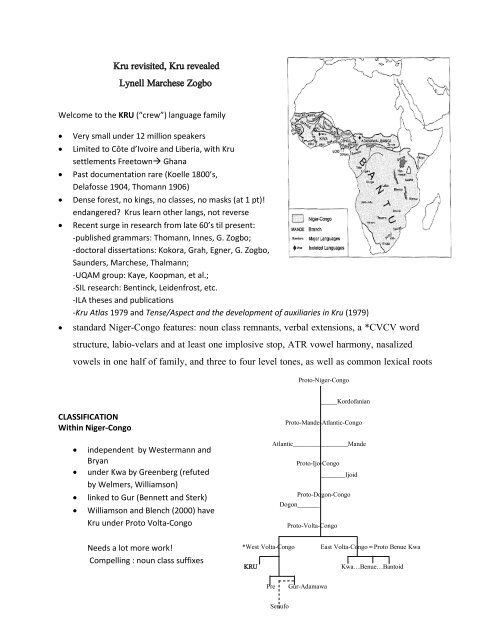
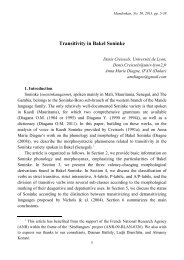
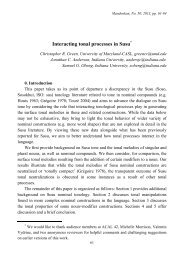
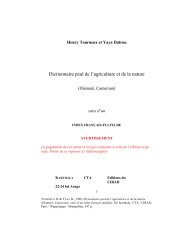
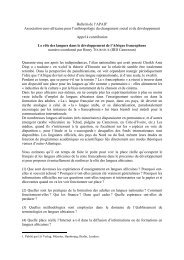
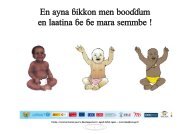
![[halshs-00645129, v1] Depressor consonants in Geji - Llacan - CNRS](https://img.yumpu.com/17832391/1/190x245/halshs-00645129-v1-depressor-consonants-in-geji-llacan-cnrs.jpg?quality=85)
